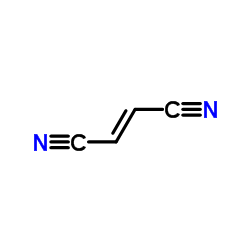反丁烯二腈

反丁烯二腈结构式

|
常用名 | 反丁烯二腈 | 英文名 | Fumaronitrile |
|---|---|---|---|---|
| CAS号 | 764-42-1 | 分子量 | 78.072 | |
| 密度 | 1.0±0.1 g/cm3 | 沸点 | 187.3±13.0 °C at 760 mmHg | |
| 分子式 | C4H2N2 | 熔点 | 93-95 °C(lit.) | |
| MSDS | 中文版 美版 | 闪点 | 82.6±13.7 °C | |
| 符号 |

GHS06 |
信号词 | Danger |
|
Effect of dosing vehicle on the toxicity and metabolism of unsaturated aliphatic nitriles.
J. Appl. Toxicol. 15(5) , 411-20, (1995) The effect of dosing vehicle on toxicity and metabolism of unsaturated aliphatic nitriles was investigated in male Sprague-Dawley rats. Five unsaturated aliphatic nitriles--acrylonitrile, methacrylonitrile, allylnitrile, crotononitrile and fumaronitrile--were... |
|
|
Ultrafast excited state dynamics of the perylene radical cation generated upon bimolecular photoinduced electron transfer reaction.
J. Phys. Chem. A 110(24) , 7547-53, (2006) The ultrafast ground state recovery (GSR) dynamics of the radical cation of perylene, Pe(*+), generated upon bimolecular photoinduced electron transfer in acetonitrile, has been investigated using pump-pump-probe spectroscopy. With 1,4-dicyanobenzene as elect... |
|
|
η1-Allylpalladium complexes with a tridentate PNP ligand with different phosphino groups.
Dalton Trans. 41(40) , 12490-500, (2012) The iminodiphosphine 2-(PPh(2))C(6)H(4)-1-CH=NC(6)H(4)-2-(PPh(2)) (P-N-P') is used for the preparation of the complexes [Pd(η(1)-CHR(1)-CH=CR(2)R(3))(P-N-P')]BF(4) [R(1) = R(2) = R(3) = H: (1); R(1) = R(2) = Ph, R(3) = H: (2); R(1) = R(3) = H, R(2) = Ph: (3);... |
|
|
Bringing nitrilase sequences from databases to life: the search for novel substrate specificities with a focus on dinitriles.
Appl. Microbiol. Biotechnol. 100 , 2193-202, (2016) The aim of this study was to discover new nitrilases with useful activities, especially towards dinitriles that are precursors of high-value cyano acids. Genes coding for putative nitrilases of different origins (fungal, plant, or bacterial) with moderate sim... |
|
|
The development of a novel strategy for the microbial treatment of acrylonitrile effluents.
Biodegradation 6(2) , 93-107, (1995) Effluent from the manufacture of acrylonitrile is difficult to biodegrade. It contains nine major organic components: acetic acid, acrylonitrile, acrylamide, acrylic acid, acrolein, cyanopyridine, fumaronitrile, succinonitrile, and maleimide. A range of bacte... |
|
|
Ultrabright and ultrastable near-infrared dye nanoparticles for in vitro and in vivo bioimaging.
Biomaterials 33(31) , 7803-9, (2012) We report a new strategy of using carrier-free pure near-infrared (NIR) dye nanoparticles (NPs) to achieve highly luminescent NIR fluorescent probes for in vitro and in vivo imaging. Bis(4-(N-(2-naphthyl)phenylamino) phenyl)-fumaronitrile (NPAPF) NPs are show... |
|
|
2H-Azirines from a concerted addition of alkylcarbenes to nitrile groups.
Org. Lett. 12(10) , 2366-9, (2010) Photolysis of aziadamantanes in the presence of fumaronitrile (FN) unexpectedly afforded conjugated 2H-azirines resulting from addition of the carbene to the CN triple bond. This represents the first example of a direct azirine formation starting from an alky... |
|
|
Synthesis, structural characterization, and unusual field-effect behavior of organic transistor semiconductor oligomers: inferiority of oxadiazole compared with other electron-withdrawing subunits.
J. Am. Chem. Soc. 131(5) , 1692-705, (2009) A new series of heterocyclic oligomers based on the 1,3,4-oxadiazole ring were synthesized. Other electron-deficient cores (fluorenone and fumaronitrile) were introduced to investigate the oligomers as n-channel materials. The physical properties, thin film m... |
|
|
Aneuploidy in Drosophila, IV. Inhalation studies on the induction of aneuploidy by nitriles.
Mutat. Res. 259(2) , 165-76, (1991) The Drosophila ZESTE system was used to monitor the induction of sex chromosome aneuploidy following inhalation exposure of adult females to four nitriles: acetonitrile, propionitrile, acrylonitrile and fumaronitrile. Acetonitrile and propionitrile were highl... |
|
|
Mutagenic activity of acetonitrile and fumaronitrile in three short term assays with special reference to autoinduction.
J. Appl. Toxicol. 8(3) , 201-9, (1988) Two aliphatic nitriles, acetonitrile and fumaronitrile were tested for their genotoxic potential in three mutagenicity test systems: the Salmonella/microsome-assay, an assay using Saccharomyces cerevisiae (strain D7), and the bone marrow micronucleus test. Bo... |